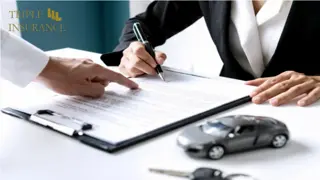Insights on Future Benefit Reserves in Health Insurance
This text delves into the complex world of future benefit reserves in health insurance, discussing key aspects such as reserving principles, challenges, and product features. It also touches upon literature reviews in the field, providing valuable insights for those interested in the topic.
Download Presentation

Please find below an Image/Link to download the presentation.
The content on the website is provided AS IS for your information and personal use only. It may not be sold, licensed, or shared on other websites without obtaining consent from the author.If you encounter any issues during the download, it is possible that the publisher has removed the file from their server.
You are allowed to download the files provided on this website for personal or commercial use, subject to the condition that they are used lawfully. All files are the property of their respective owners.
The content on the website is provided AS IS for your information and personal use only. It may not be sold, licensed, or shared on other websites without obtaining consent from the author.
E N D
Presentation Transcript
Future Benefit Reserves Rajesh Dalmia (Views presented are that of the author and his employer Ernst & Young has no responsibility for the same)
Agenda Introduction Comparison of Few Product Features Literature Review (GR) Future Benefit Reserving Re-current diseases (in claim portfolio) Promised benefits triggering in future Well-ness benefit Conclusion Page 2 10 September 2024 Future Benefit Reserves - Health Seminar 2017
Reserving principles - Liability adequate recognized premiums - Liability adequate unrecognized premium portion - Liability for future claims/benefits/expenses allowing credit of future premiums - (accounts for any guarantees) - No credit is taken from future new business (except probably contribution towards ongoing maintenance expense levels) - Usually premium and reserving do not talk to each other (?) Page 3 10 September 2024 Future Benefit Reserves - Health Seminar 2017
Challenges in Health Insurance Reserving - Multiple waiting period for various diseases/PED (different for different products) - Guaranteed renewability recurrent disease - Different benefits for different variants (maternity, No claim bonus/discounts etc) - Portability no age limit to any product Page 4 10 September 2024 Future Benefit Reserves - Health Seminar 2017
Product Features in the market impact on reserves (?) - Maternity Cover, New-born baby (incl vaccination) , ambulance - OPD cover, Health Check-ups, immunizations, counselling, specialist/second opinion, online facility, ayush, gym discounts - Restoration / Recharge, no claim bonus, deductability - Hospital cash, world-wide cover, co-pay, savings a/c, pre/post variation, - Discounted single premiums, region based co-pay, Page 5 10 September 2024 Future Benefit Reserves - Health Seminar 2017
Literature Review (GR) - Pauly, Kunreither and Hirth (1995) showed that in a simple two period model, GR premium should be front loaded. Claim Frequency Crude (2013 - 14) % increase in Risk Premium Age band* Risk Severity Premium 3.75% [0-5) 25,101 941 2.78% -39.37% [6-15] 20,522 571 4.20% 107.29% [16-25] 28,137 1,183 4.89% 33.60% [26-35] 32,316 1,580 8.25% 89.31% [36-45] 36,252 2,991 7.94% 3.80% [46-55] 39,105 3,105 16.61% 106.27% [56-60] 38,549 6,404 20.06% 30.11% [61-65] 41,530 8,332 24.67% 24.22% [66-70] 41,954 10,351 Page 6 10 September 2024 Future Benefit Reserves - Health Seminar 2017
Literature Review (GR) - Pauly and Herring (2006/3) developed a theoretical markov model to estimate the cost of GR and found it to be approximately 20% of risk premium for females and 30% for males (on npv basis). Page 7 10 September 2024 Future Benefit Reserves - Health Seminar 2017
Literature Review (GR) - Frick (1998) showed that in non-perfect capital markets the front loading would not enable young to undertake the insurance - Pauly and Herring (2006/3) developed a theoretical markov model to estimate the cost of GR and found it to be approximately 20% of risk premium for females and 30% for males (on npv basis). - Feyter (2008) estimated that the cost of selective lapsation for a mature health insurance portfolio is 1-1.5% over the ultimate claim rate for every additional year of claims. - Elikhis surveyed NZ insurer to find out how many keep this reserve and found only one of them do it. Page 8 10 September 2024 Future Benefit Reserves - Health Seminar 2017
Literature Review (GR) Page 9 10 September 2024 Future Benefit Reserves - Health Seminar 2017
Premium and Risk patterns Age band* % increase in Risk Premium Risk Premium Insurer A Insurer B Insurer C Insurer C [0-5) 941 -39.37% [6-15] 571 107.29% [16-25] 1,183 3,410 5,887 5,060 33.60% 0% 0% 0% [26-35] 1,580 3,410 5,887 5,060 89.31% 24% 13% 6% [36-45] 2,991 4,218 6,662 5,348 3.80% 129% 85% 144% [46-55] 3,105 9,641 12,321 13,070 106.27% 16% 29% 21% [56-60] 6,404 11,187 15,907 15,813 30.11% 58% 39% 4% [61-65] 8,332 17,651 22,089 16,503 24.22% 38% #VALUE! 39% [66-70] 10,351 24,272 N/A 23,000 Page 10 10 September 2024 Future Benefit Reserves - Health Seminar 2017
FBR / Contract reserving - AAA required where present value of future benefits exceeds the present value of future premiums (all in-force, only in claim? ) - Not required when rates for a particular block of contracts are determined in such a manner that each year s premium is intended to cover that year s cost with no pre-funding of future years costs from the current year s premium or when contracts which cannot be continued after one year from issue. - Approaches similar to pricing but with margins in the current assumptions is advised by AAA Page 11 10 September 2024 Future Benefit Reserves - Health Seminar 2017
FBR / Contract reserving - Do nothing approach Only when company has shown a pattern of increasing rates when future benefit increases - Benefit rider / proportional approach each year recognize the increase and allow that in the basis - New factor approach recalcualte the reserves using the current best estimates for future - Loss ratio approach project target loss ratio based on pricing assumption for a block of business. Use this to develop expected incurred claim amount with margin. Reserve is difference between this and the actual claims. Page 12 10 September 2024 Future Benefit Reserves - Health Seminar 2017
Conclusions - Reserving - Assumptions between pricing and reserving will differ due to change in business mix age / variant / term / zone / floater / options etc - Additionally, there should be some margin for prudence - Actual in claim status allowing for recurrence and deterioration of portfolio - Claim inflation every year but premium inflation is in steps allowing for regulatory constraints - Rationality assumption for policyholder Page 13 10 September 2024 Future Benefit Reserves - Health Seminar 2017
Thank You dalmia.rajesh@gmail.com Page 15 10 September 2024 Future Benefit Reserves - Health Seminar 2017























